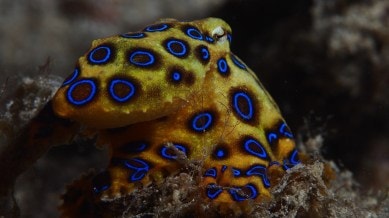📣 For more lifestyle news, click here to join our WhatsApp Channel and also follow us on Instagram
Meet the most dangerous octopus in the world whose poison can kill humans within minutes
It’s easy to panic when you hear about a creature that can kill in minutes. But the truth is, the blue-ringed octopus doesn’t want to hurt humans.

It doesn’t look like a monster. In fact, it could fit in the palm of your hand. Barely the length of a finger, with delicate arms and a soft body, the blue-ringed octopus almost seems harmless at first glance. But looks deceive: this tiny creature carries one of the most powerful toxins known to science, a poison so strong it can kill a human within minutes, and there’s still no antidote.
“Beautiful but deadly” is a phrase often used for wild animals, but in the case of the blue-ringed octopus, it’s chillingly accurate. Its warning sign is impossible to miss: when threatened, its skin flashes with vivid blue rings that pulse like neon lights under the water. It’s nature’s version of a hazard sign, and it means one thing: Don’t Touch.
monthly limit of free stories.
with an Express account.
Why so dangerous?
The secret weapon of the blue-ringed octopus is tetrodotoxin (TTX). The same poison found in pufferfish, it attacks the nervous system by blocking signals between nerves and muscles. First, your lips and tongue may go numb. Then, paralysis sets in. Without immediate help, the diaphragm, the muscle that powers breathing, shuts down. Death can follow in under an hour.
Doctors and divers who’ve seen it up close say the most terrifying part is that the victim remains fully conscious while their body stops obeying them. There’s no cure. The only chance of survival is emergency first aid and assisted breathing until the toxin leaves the system.
Small but striking
For all its deadly reputation, the animal itself is surprisingly tiny. Most blue-ringed octopuses measure just 10 to 20 centimeters across when you include the arms, with bodies no larger than a golf ball. They spend their days tucked away in crevices or shells, venturing out to hunt small crabs and shrimp at night.
When calm, their colours are muted browns and yellows. But the moment they feel threatened, the luminous blue rings blaze across their skin like an underwater light show. Those rings are a last warning before the octopus bites.
Where are they found?
Blue-ringed octopuses live across the Indo-Pacific region. They’re most often spotted in shallow reefs and tide pools in Australia, the Philippines, and parts of Japan. Recently, scientists have also tracked the blue-lined octopus along the Korean coast, a sign that their range may be shifting with changing waters.
Because they prefer to hide under rocks and shells, people usually come across them by accident, often when picking up shells in tidal pools. That’s why marine experts constantly remind beachgoers: look, admire, but never touch.
How dangerous are encounters?
Despite their fearsome reputation, deaths from blue-ringed octopuses are very rare. These animals don’t go looking for trouble, and they bite only if provoked or stepped on. Documented cases of fatalities are only a handful. Still, each one is enough to keep divers, swimmers, and doctors wary.
The danger is partly because the bite itself is so small it can go unnoticed until symptoms appear. One moment you might feel a little prick, the next you’re struggling to breathe.
If the worst happens, the difference between life and death often lies in how quickly people respond.
- Call emergency services immediately.
- Wrap the bitten limb with a pressure-immobilisation bandage (a tight bandage and splint to slow the spread of venom).
- Keep the victim still.
- If breathing falters, start rescue breaths or CPR and don’t stop until trained help arrives.
People have survived blue-ringed octopus bites because bystanders kept them breathing long enough for the toxin to wear off.
In 2025, researchers revealed a startling detail about the blue-lined octopus. Male octopuses, it turns out, sometimes inject a little tetrodotoxin into females while mating. The temporary paralysis may be a way of protecting themselves, female octopuses are notorious for eating their mates. Thankfully, the females recover within minutes. It’s a strange reminder that even their love lives are shaped by venom.
It’s easy to panic when you hear about a creature that can kill in minutes. But the truth is, the blue-ringed octopus doesn’t want to hurt humans. It spends its life hunting small crustaceans, hiding in rocks, and avoiding predators. If left alone, it poses no danger at all.
The lesson, then, is simple: if you ever spot one while snorkeling or walking along a reef, admire the glowing rings from a safe distance.
📣 For more lifestyle news, click here to join our WhatsApp Channel and also follow us on Instagram